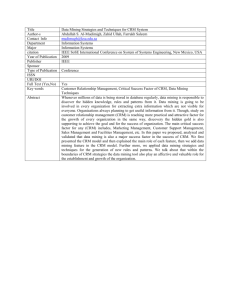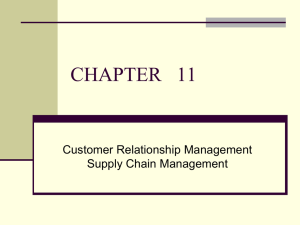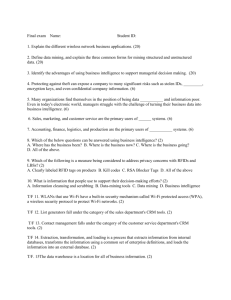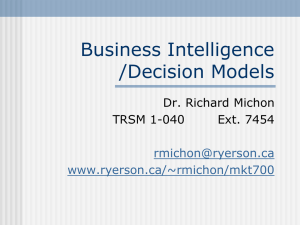The research on a system framework & an application of analytical
advertisement
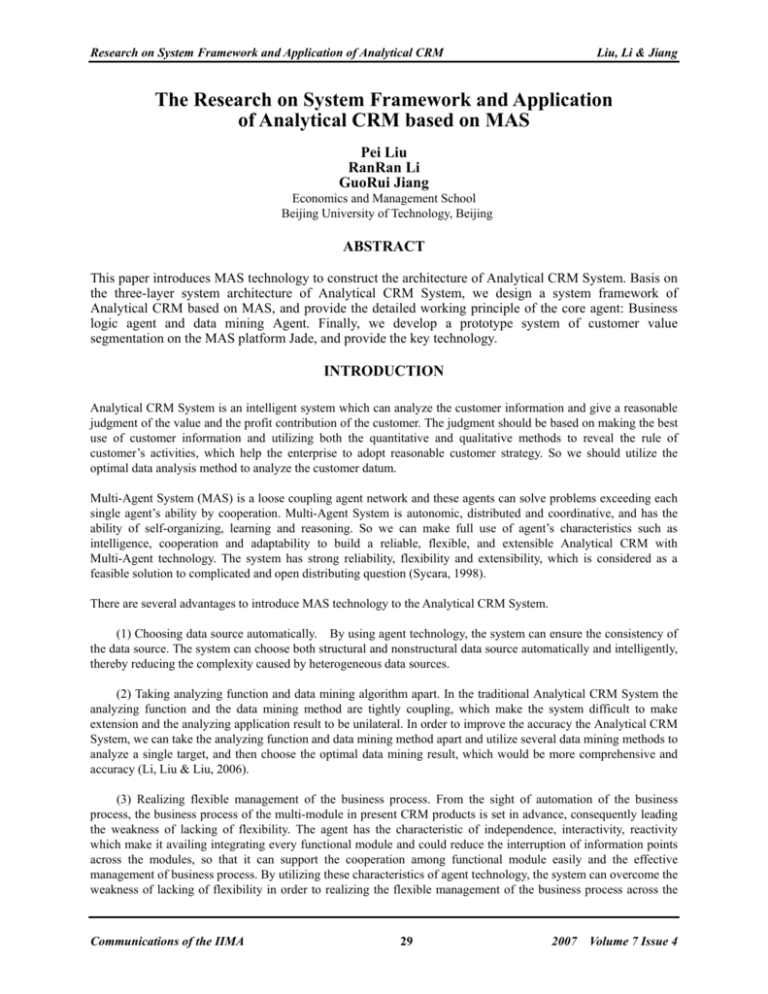
Research on System Framework and Application of Analytical CRM
Liu, Li & Jiang
The Research on System Framework and Application
of Analytical CRM based on MAS
Pei Liu
RanRan Li
GuoRui Jiang
Economics and Management School
Beijing University of Technology, Beijing
ABSTRACT
This paper introduces MAS technology to construct the architecture of Analytical CRM System. Basis on
the three-layer system architecture of Analytical CRM System, we design a system framework of
Analytical CRM based on MAS, and provide the detailed working principle of the core agent: Business
logic agent and data mining Agent. Finally, we develop a prototype system of customer value
segmentation on the MAS platform Jade, and provide the key technology.
INTRODUCTION
Analytical CRM System is an intelligent system which can analyze the customer information and give a reasonable
judgment of the value and the profit contribution of the customer. The judgment should be based on making the best
use of customer information and utilizing both the quantitative and qualitative methods to reveal the rule of
customer’s activities, which help the enterprise to adopt reasonable customer strategy. So we should utilize the
optimal data analysis method to analyze the customer datum.
Multi-Agent System (MAS) is a loose coupling agent network and these agents can solve problems exceeding each
single agent’s ability by cooperation. Multi-Agent System is autonomic, distributed and coordinative, and has the
ability of self-organizing, learning and reasoning. So we can make full use of agent’s characteristics such as
intelligence, cooperation and adaptability to build a reliable, flexible, and extensible Analytical CRM with
Multi-Agent technology. The system has strong reliability, flexibility and extensibility, which is considered as a
feasible solution to complicated and open distributing question (Sycara, 1998).
There are several advantages to introduce MAS technology to the Analytical CRM System.
(1) Choosing data source automatically. By using agent technology, the system can ensure the consistency of
the data source. The system can choose both structural and nonstructural data source automatically and intelligently,
thereby reducing the complexity caused by heterogeneous data sources.
(2) Taking analyzing function and data mining algorithm apart. In the traditional Analytical CRM System the
analyzing function and the data mining method are tightly coupling, which make the system difficult to make
extension and the analyzing application result to be unilateral. In order to improve the accuracy the Analytical CRM
System, we can take the analyzing function and data mining method apart and utilize several data mining methods to
analyze a single target, and then choose the optimal data mining result, which would be more comprehensive and
accuracy (Li, Liu & Liu, 2006).
(3) Realizing flexible management of the business process. From the sight of automation of the business
process, the business process of the multi-module in present CRM products is set in advance, consequently leading
the weakness of lacking of flexibility. The agent has the characteristic of independence, interactivity, reactivity
which make it availing integrating every functional module and could reduce the interruption of information points
across the modules, so that it can support the cooperation among functional module easily and the effective
management of business process. By utilizing these characteristics of agent technology, the system can overcome the
weakness of lacking of flexibility in order to realizing the flexible management of the business process across the
Communications of the IIMA
29
2007
Volume 7 Issue 4
Research on System Framework and Application of Analytical CRM
Liu, Li & Jiang
functional modules.
(4) Supporting effective collaboration among agents in CRM. From the sight of cooperation, each agent can
communicate with other agents using the advanced agent language, such as KQML or ACL, making modules of the
analytical CRM collaborating with each other much more effective.
THREE-LAYER SYSTEM FRAMEWORK OF ANALYTICAL CRM MODEL
Analytical CRM System has the features such as the large amount of data and the complicated analysis method, as
well as the diversity of data request and analysis request. In response to the features above, the Analytical CRM
model can be divided into three layers in accordance with the thinking of layered system: the user interface layer,
application service layer, data service layer (Li, 2002).
There are two kinds of interfaces in the user interface layer: User-oriented interface and interface for supporting
other parts of the enterprise CRM system. These two kinds of interfaces can accept external request, interact with
external environment and the application service layer.
The Application service layer is in charge of the concrete process of business logic. For the sake of clarity, the
application service layer can be divided into four parts as following. The transmission from top to bottom among
those layers is control flow and in the opposite direction is data flow.
(1) Application organizing layer: It mainly deals with users' analysis request and the template of display the
result users designated. It can decompose users' analysis request to several business problems which can be dealt
with by the business logic layer, and organize the results of returning business process according to the template
users required.
(2) Business logic layer: It can separate concrete assignments of business logic from data mining tasks, which
will improve the extendibility of the system and reduce the coupling of the system.
(3) Analytical function processing layer: It encapsulates multivariate statistical analysis methods and data
mining algorithms and other analytical methods in the system. It is the core of Analytical CRM, because any system
used to deal with datum will ultimately rely on concrete algorithms.
(4) Data access layer: According to the metadata of data storage (data warehouse, ODS, etc.) of the bottom
layer, it answers for translating data request into the request to every concrete data source, thereby providing the data
accessing service which can shield the detailed storage of the bottom layer.
The Data service layer is in charge of establishing, maintenance and access of the data source from data warehouse,
data marts and ODS etc. It also manages the metadata of each data storage section and provides the corresponding
interface. Enterprises have huge complicated all kinds of internal data systems and CRM system needs a lot of
external supporting datum in addition, so it's a very complicated process for data cleaning, data extraction, data
transformation and data loading. As a result, data mining will make no sense without a successful subject oriented
data warehouse and ODS.
Obviously, the application service layer is the main body of implementing the analysis logic function for the
Analytical CRM.
THE FRAMEWORK DESIGN OF ANALYTICAL CRM SYSTEM BASED ON MAS
System functions and System framework
We divided the application service layer into several classes of agent: AMS(Agent Management System),
DF(Directory Facilitator), ACC(Agent Communication Channel), CA(Customer Agent), AOA(Application
Communications of the IIMA
30
2007
Volume 7 Issue 4
Research on System Framework and Application of Analytical CRM
Liu, Li & Jiang
Organizing Agent), BLA(Business Logic Agent), DMA(Data Mining Agent), Data Service Agent(DSA). At the same
time, these Agents are divided into several layers as following:
(1) Management layer: Management layer answers for the management of Multi-Agent platform. It
implements the foundation framework based on FIPA(Foundation for Intelligent Physical Agents, www.fipa.org),
which is used for the mutual communication between these agents.
This layer contains three MA (Management Agent): AMS, DF and ACC.
AMS manages the activity of Agent platform, including establishing agents and deleting them from it. It decides
whether a certain agent can register in the platform, and monitor the agents’ movement from this platform to another
platform. Furthermore, AMS preserves all the indexes of the current agents on the platform. DF provides the
Directory Facilitator service for the agents on the platform, and answers for the management of their catalog. Other
agents can register their services into DF, and inquire the provider about a certain service. ACC takes charge of the
bottom communication of the agents both inside and outside the platform. All the agents (containing DF and AMS)
visit at least one ACC for the communication with other Agents.
(2) Customer layer: Customer Agent (CA): It works as a representative of users for interaction with the
system. CA collects the analysis request from users and sends it to AOA. It takes over the return from AOA and lay
out it to users.
(3) Business Logic layer: This layer has two kinds of agents: AOA and BLA.
AOA takes over the analysis request from CA, and divides it into several business issues and dispatches them to
several related BLA; it takes over the results from a number of Business Logic Agents, reorganizes them in terms of
users’ requirement, and then sends them to CA.
BLA has encapsulated the concrete business logic model. The system structure that packages each business logics
into agent is flexible, and it is quite convenient to add the new BLA in terms of requirement in such a system. The
model base of BLA only stores the best business logic model. If there is no the best business logic model in model
base, then the BLA compares a number of business logic models using the model evaluation knowledge from the
knowledge base, and store the best one into knowledge base.
(4) Data mining layer: DMA (Data Mining Agent) encapsulates many concrete multivariate statistics and
data mining algorithms. It takes over the data request and algorithm list from BLA and delivers the data request to
DSA. Based on the dataset returned, it implements algorithm analysis by the algorithms from algorithm base in
terms of the algorithm list, and finally returns the model result to BLA.
(5) Data Service layer: Data Service Agent: It takes over the data request from DMA, extracts the required
data from data warehouse, implements data preparation according to the data request and returns the dataset which is
prepared for latter analyzing to BLA.
The system framework is shown as Figure 1:
Communications of the IIMA
31
2007
Volume 7 Issue 4
Research on System Framework and Application of Analytical CRM
Liu, Li & Jiang
Figure 1: The system framework of Analytical CRM Based on multi-agent.
Customer layer
AMS
DF
ACC
Management layer
CA1
BLA 1
CA2
……
AOA
…
Communication mechanism
…
CA n
BLA 2
Business logic layer
BLA n
DMA
DSA
Data mining layer
Data service layer
Where “CAi” denotes the ith Customer Agent, “AMS” Agent Management System ,“DF ” Directory
Facilitator ,“ACC” Agent Communication Channel ,“AOA ” Application Organizing Agent, “BLAi” the ith Business
Logic Agent, “DMA” Data Mining Agent , “DSA” Data Service Agent.
Design of the BLA
Customer segmentation is one of the most important function of Analytical CRM, so we take CSA(Customer
Segmentation Agent) for example to illustrate the working principle of BLA in Analytical CRM, the working
principle of other BLA is the same.
The model structure is shown as Figure 2:
Communications of the IIMA
32
2007
Volume 7 Issue 4
Research on System Framework and Application of Analytical CRM
Liu, Li & Jiang
Figure 2: The model structure of Business Logic Agent.
Where “CM” denotes Communication Model, “MQ” Message Queue, “MDDO” Message Distinguishing and
Distributing Organ, “TOO” Task Output Organ, “RO” Reasoning Organ, “KBMO” Knowledge Base Management
Organ, “MBMO” Model Base Management Organ ,“KB” Knowledge Base, “MB” Model Base.
There are two kinds of messages that CSA take over: the request of customer segmentation and the set of model
result. Customer segmentation request contains two important metalanguages: data mining parameters and data
source. For example, a customer segmentation request could be described as “Segment the customers into 8 classes,
according to the sales datum in 1998 and the customer value.” “Sales datum in 1998” is the description of data
source, and “8 classes” is the description of data mining parameters. The two metalanguages: data mining
parameters and data source also can be used as fields to query knowledge base and model base.
There are also two kinds of messages that sent by CSA: the best model result sent to AOA, and the data mining
request sent to DMA.
The messages that CSA sent or take over are transmitted by Communication Model (CM). The messages sent by
other agents are put into Message Queue (MQ), then the Message Distinguishing and Distributing Organ (MDDO)
distinguishes the datum from these messages and distributes them; the datum put out by CSA are packaged by Task
Output Organ (TOO) and sent to other agents. The Knowledge Base (KB) has two kinds of knowledge: model
evaluation knowledge and the algorithm list that is used by customer segmentation frequently. The models stored in
Model Base (MB) are the best model for diversified customer segmentation request respectively.
The working flow of CSA is as following:
(1) If the message distinguished by MDDO is customer segmentation request, then the Model Management
Organ (MMO) implements query in MB. If MB has the conformable model, then the CSA put out the model result
through TOO; if no conformable model exists in MB, then Knowledge Base Management Organ (KBMO) queries
Communications of the IIMA
33
2007
Volume 7 Issue 4
Research on System Framework and Application of Analytical CRM
Liu, Li & Jiang
the algorithm list from KB and puts it into MQ. The algorithm list with the data mining parameters and data source
from customer segmentation request together are packaged into data mining request, which is to be sent to DMA.
(2) If the message distinguished by MDDO is model result set, then the CSA sent it to Reasoning Organ (RO).
Through reasoning by RO with the model evaluation knowledge from KB, the CSA puts out the best model result as
well as storing it into MB.
Design of DMA
The model structure of DMA is shown as figure 3:
Figure 3: The model structure of Data Mining Agent.
CM
Other
Agent
TOO
MQ
model
result
data source
request
MQ
RO
dataset
data mining
parameter
MDDO
DSZ
dataset
algorithm
list
algorithm
request
AB
TSO
Where “CM” denotes Communication Model, “MQ” Message Queue, “MDDO” Message Distinguishing and
Distributing Organ, “TSO” Task Scheduling Organ, “TOO” Task Output Organ, “RO” Reasoning Organ, “DSZ”
Data Store Zone, “AB” Algorithm Base.
There are two kinds of messages that DMA take over: the data mining request sent by BLA and the dataset sent by
DSA. Data mining request contains data source, data mining parameters and algorithm list.
There are also two kinds of messages that sent by DMA: the model result sent to BLA and data request sent to DSA.
MDDO takes charge of distinguishing and taking messages apart. If the message is data mining request, MDDO
extracts data source request, data mining parameters and algorithm list from it. Then the data source request is sent
to DSA for dataset through MQ; the data mining parameters are sent to RO; the algorithm list is sent to Task
Scheduling Organ (TSO). If the message is dataset, MDDO puts it into Data Store Zone (DSZ).
TSO takes charge of scheduling the algorithms in algorithm list, and in turn sends the related algorithm request to
DSA.
RO is in charge of concrete analyzing calculation by calling for the algorithm in Algorithm Base (AB) in terms of
Communications of the IIMA
34
2007
Volume 7 Issue 4
Research on System Framework and Application of Analytical CRM
Liu, Li & Jiang
algorithm request, and the dataset in DSZ. Through concrete data mining calculation, RO puts out model
results to MQ.
TOO takes charge of packaging the model results in MQ into model result set message, and sends them to BLA
through CM.
AN APPLICATION EXAMPLE
On the Basis of the Analytical CRM system framework based on MAS, we developed a prototype system on Jade,
which is a popular MAS development platform. This prototype system realized a customer value segmentation
method based on AHP (CVS-AHP) (Jiang, Liu & Huang, 2007).
A MAS development platform—Jade
Jade is a software development framework of interactive MAS system, which complies with FIPA standards. It
makes the application development based on agent more easily (jade.tilab.com, 2005). Jade provides a suit of
comprehensive system services and agents to simplify the application development. The interactive language used in
Jade is ACL (Agent Communication Language) [4], which is the standard agent communication language defined by
FIPA. ACL language is based on the theory of Speech-Act, and its message expresses the communication action,
which is to say, agent attempt to achieve or accomplish a specific intention and action by sending messages. It
includes more than 20 so-called communicative act and corresponding grammars and semantic expressions. Each
communicative act is composed of title (indicating the message type, meaning, and communication intention) and
message parameters.
System function and its interactive structure
According to the requirement, we divided the agents in customer value segmentation system based on MAS into
three kinds: CA (Customer Agent), CSA (Customer Segmentation Agent) 1 and DSA (Data Service Agent).
Customer Agent mainly implements the following functions: putting in the weight parameters of AHP to weigh the
related data in dataset, and sending the data preparation service request to DSA; taking over the dataset prepared by
DSA, using k-means algorithm to implement analysis process on it, and then returning the analysis results to CA.
DSA mainly deals with the raw dataset from data warehouse according to customer’s concrete data request,
consequently providing the dataset customer need. It has the following functions: taking over the data preparing
request from customers, taking out the raw dataset from warehouse of datum and prepare the dataset of customer
need; taking over the data request from CSA, and returning the dataset prepared to CSA for analyzing.
The interactive structure is shown as figure 4:
1
Due to CVS-AHP need not to compare several model results, we integrated the function of DMA into CSA
Communications of the IIMA
35
2007
Volume 7 Issue 4
Research on System Framework and Application of Analytical CRM
Liu, Li & Jiang
Figure 4: The interactive structure of Agents in the system.
r
pr
as
CA
p
ah
ar
r
-p
CSA
wds
dr
DSA
DW
ar: analysis request
as: analysis result
prr: parameter request reply
pr: parameter request
wds: weighed dataset
dr: data request
rds: raw dataset
The message interactive mechanism design
According the segmentation of business process, the interaction of messages in the system is divided into two kinds:
the interaction of message when customer requests the data service and the other when customer requests customer
segmentation. Both the initiator and recipient is customer Agent.
The working flow of the first kind of message interaction is: CA sends the weight parameter of AHP to DSA. DSA
reply the parameters request to CA on the basis of the data preparation by DSA.
The characteristic of the first kind of message is the few data transmitted. We can use the standard message
mechanism to resolve it, which is using “content” field to transmit a string. For example, the message format that
CA sends data preparing request to DSA is as following:
(inform
:sender CA
:receiver DSA
:content (weigh parameter of AHP )
:language …
:conversationId …
)
The working flow of the second kind of message interaction is: CA sends analysis request to CSA, and then CSA
sends data request to DSA; DSA takes over the data request, prepares the dataset according to the data request and
Communications of the IIMA
36
2007
Volume 7 Issue 4
Research on System Framework and Application of Analytical CRM
Liu, Li & Jiang
sends it to CSA; On the basis of analysis processing on dataset returned, CSA returns the analysis result to CA.
The characteristic of the second kind of message is the great amount of data transmitted. The dataset that DSA sends
to CSA and the analysis result that CSA sends to CA belong to this kind. It is obviously that it is difficult to realize
this kind of message transmission mechanism by standard message mechanism. The API in Jade provides the
method transmitting object, so we encapsulate the dataset or the analysis result into object which need be
transmitted.
We make the object transmitted and all the objects comprised in it serialized, and then utilize the methods:
“setContentObject” and “getContentObject” provided in jade which could transmit serialized objects. In this way,
we can implement transmitting objects as the content of ACL message.
For example, when DSA transmits the dataset to CSA, the segment of concrete code is as following:
DSA of sending end:
SegReply.setLanguage("JavaSerialization"); //define the type of ACL language
SegReply.setContentObject(pdataPoints); // set dataset object as message content
myAgent.send(SegReply); //DSA send message
CSA of receiving end:
if ("JavaSerialization".equals(msgfromD.getLanguage())) //check the type of ACL message
{dataPoints = (Vector) msgfromD.getContentObject();}// accept dataset object
“SegReply” denotes the ACL message from DSA to CSA.
CONCLUSION
Applying the MAS technology into Analytical CRM is an embodiment of the intelligence of Analytical CRM. MAS
technology can not only reduce the coupling degree among the modules of Analytical CRM system, so that improve
the flexibility and extendibility of business process of it, but also make the best use of the ability that MAS system
solving complicated problem, and so it is in favor of the collaborative working among the modules of Analytical
CRM effectively.
This paper brought forward the Analytical CRM system framework based on MAS technology. Through the detailed
research of the working principle of several core agents, we developed a prototype system which can be used in
customer value segmentation, and consequently demonstrates the effectiveness and feasibility of MAS introducing
to Analytical CRM system.
REFERENCES
1 Sycara K. P. (1998). Multiagent systems. AI magazine [J], summer,79~92.
2 LI Bin, LIU Wen Huang, LI Xiu. (2006). Intelligent Information Architecture of Analytical Type CRM[J], Aerial
manufacture technology, (11):94-97.
3 LI Hai Ming. (2002). The software Architecture of Analytical CRM[J]. Computer engineering and application.
(5):110-112.
4 http://www.fipa.org/specs/fipa00018/OC00018A.pdf. FIPA 97 Specification, Part2, Agent Communication
Language. Technical Committee of FIPA.
5 JIANG Guo Rui, LIU Pei, HUANG Ti Hun. (2007). Research of customer value segmentation based on AHP
method[J]. Computer engineering and application. (8):238-241.
6 http://jade.tilab.com/doc/programmersguide.pdf. JADE Programmer's GUIDE. 2005.
Communications of the IIMA
37
2007
Volume 7 Issue 4
Research on System Framework and Application of Analytical CRM
Communications of the IIMA
38
Liu, Li & Jiang
2007
Volume 7 Issue 4
